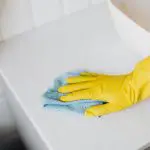So, you've managed to get a permanent marker stain on your favorite fabric. No need to panic!
Here are 5 simple methods to help you tackle this pesky problem. From using rubbing alcohol to applying lemon juice and baking soda, these techniques will empower you to become a stain-fighting pro.
Whether it's a cherished shirt or a beloved couch cushion, these solutions will assist you in restoring your fabric to its former glory.
Let's dive in and bid farewell to those stubborn marker stains!
Key Takeaways
- Solvents such as rubbing alcohol, nail polish remover, and hairspray can be effective in removing permanent marker stains from fabric.
- Natural ingredients like lemon juice and baking soda can also be used to remove marker stains.
- A mixture of dish soap and white vinegar can be an alternative solution for removing marker stains.
- It is important to test the chosen method on a small area of the fabric and work in a well-ventilated area to avoid damage or discoloration.
Using Rubbing Alcohol
You should carefully and gently dab the stained area with a cotton ball soaked in rubbing alcohol to begin breaking down the permanent marker stain. This method is effective in loosening the pigment from the fabric fibers. After applying the rubbing alcohol, let it sit for a few minutes to allow it to penetrate the stain.
Then, using a clean cloth, blot the area to lift the marker pigment from the fabric. It's essential to test the rubbing alcohol on a small, inconspicuous area of the fabric first to ensure it doesn't cause any damage or discoloration.
When using alternative solvents, such as nail polish remover or hand sanitizer, it's important to remember that these products may contain additional chemicals that could potentially damage the fabric. Always test these solvents on a hidden area of the fabric and proceed with caution.
Safety precautions include working in a well-ventilated area when using rubbing alcohol or any other solvents. Additionally, avoid using these solvents near open flames or heat sources, as they're flammable. Always follow the manufacturer's instructions and warnings when using solvents on fabric.
Applying Nail Polish Remover
After applying the rubbing alcohol and blotting the stained area, it's time to consider using nail polish remover as an alternative solvent to remove the permanent marker stain from fabric. Remember to test the nail polish remover on a hidden area of the fabric before proceeding further.
When using nail polish remover as an acetone alternative to remove permanent marker stains from fabric, follow these steps to ensure fabric safety:
- Dab a small amount of nail polish remover onto a clean cloth.
- Gently blot the stained area, taking care not to rub too vigorously to avoid damaging the fabric fibers.
- Continue blotting until the stain starts to lift.
- Once the stain begins to fade, launder the fabric as usual to remove any remaining residue.
Remember that nail polish remover contains acetone, which can be harsh on some fabrics. Always test it on a hidden area first and proceed with caution to avoid damaging the fabric. With careful application, nail polish remover can be an effective solution for removing permanent marker stains from fabric.
Utilizing Hairspray
An effective method for removing permanent marker stains from fabric involves utilizing hairspray as a solvent. Hairspray contains alcohol, which can help break down the pigments in the permanent marker, making it easier to remove from the fabric.
To begin, place a clean cloth underneath the stained area to prevent the marker from spreading to other parts of the fabric. Then, spray a small amount of hairspray directly onto the stained area. Allow the hairspray to sit on the fabric for a few minutes to penetrate the stain.
Afterward, gently blot the area with a clean cloth to lift the marker stain. Repeat the process as needed until the stain begins to fade.
It's important to note that hairspray may not be suitable for all fabric types, especially delicate or dry-clean-only fabrics. Before applying hairspray, it's recommended to test it on a small, inconspicuous area of the fabric to ensure it doesn't cause any damage or discoloration.
Once the stain is removed, wash the fabric according to the care instructions to eliminate any remaining hairspray residue.
Using Lemon Juice and Baking Soda
Lemon juice and baking soda effectively remove permanent marker stains from fabric. This DIY stain remover isn't only effective but also a natural fabric cleaner. Here's how you can use them to eliminate those stubborn stains:
- Create a paste: Mix lemon juice and baking soda to form a paste with a toothpaste-like consistency.
- Apply the paste: Gently spread the paste onto the stained area, ensuring it covers the entire affected area.
- Let it sit: Leave the paste on the fabric for 10-15 minutes to allow it to penetrate and lift the stain.
- Rinse and wash: After the allotted time, rinse the fabric with cold water and launder it as usual.
Using lemon juice and baking soda as a natural fabric cleaner is an eco-friendly and cost-effective way to tackle permanent marker stains. This method not only helps in stain removal but also leaves your fabric smelling fresh. Give this DIY stain remover a try and see the magic unfold before your eyes.
Applying Dish Soap and White Vinegar
To continue removing permanent marker stains from fabric, mix one tablespoon of dish soap with two tablespoons of white vinegar. This method is effective for tackling tough stains on durable fabrics such as cotton, polyester, and nylon. Dish soap is known for its grease-cutting properties, making it effective in breaking down the marker pigments, while white vinegar acts as a natural stain remover and deodorizer. When combined, these two ingredients create a powerful stain-fighting solution.
Dish soap is gentle enough to use on most fabrics, but it's always best to test a small, inconspicuous area first to ensure that it doesn't cause any damage or discoloration. White vinegar is also generally safe for use on many fabrics, but it's advisable to avoid using it on delicate fabrics such as silk or wool, as it may cause damage.
When applying the dish soap and white vinegar solution, gently blot the stained area with a clean cloth, working from the outside of the stain towards the center to prevent spreading. Allow the solution to sit for a few minutes before rinsing with cold water and laundering as usual.
Frequently Asked Questions
Can Permanent Marker Stains Be Removed From Delicate Fabrics Such as Silk or Lace Using These Methods?
Yes, you can remove permanent marker stains from delicate fabrics like silk or lace. Use gentle methods to ensure silk care and lace preservation. Consider testing on a small hidden area first.
Are There Any Potential Risks or Side Effects to Using Rubbing Alcohol, Nail Polish Remover, Hairspray, Lemon Juice, Baking Soda, Dish Soap, or White Vinegar on Fabric?
Using rubbing alcohol, nail polish remover, hairspray, lemon juice, baking soda, dish soap, or white vinegar on fabric may cause potential risks like skin irritation. The effectiveness of these methods varies depending on the fabric type.
Can These Methods Be Used on Colored or Patterned Fabrics Without Causing Damage or Discoloration?
Using rubbing alcohol, nail polish remover, hairspray, lemon juice, baking soda, dish soap, or white vinegar may be effective on dark fabrics. However, there is potential for color fading, so test on a small hidden area first.
How Effective Are These Methods on Older or Set-In Permanent Marker Stains?
For older permanent marker stains, the effectiveness of set-in stain removal techniques varies. Some methods may lighten or remove the stains, but complete removal is not guaranteed. It's best to test on a small, inconspicuous area first.
Are There Any Alternative Methods or Products That Can Be Used to Remove Permanent Marker Stains From Fabric?
For removing permanent marker stains from fabric, consider alternative methods like using rubbing alcohol or eco-friendly options such as a baking soda and vinegar paste. These can be effective and safe for the environment.
- The Use of Nonwovens in Construction and Civil Engineering - July 11, 2025
- The Use of Nonwovens in Construction and Civil Engineering - July 11, 2025
- The Use of Nonwovens in Construction and Civil Engineering - July 11, 2025







